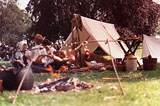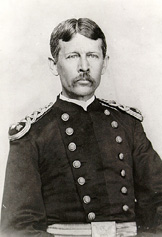




In North America, settlements were established by the English during the sixteenth and seventeenth century. Places such as Roanoke, Jamestown and Williamsburg are well known. What is less well known is that these settlements were at the mercy of diseases that were not common in Europe. Populations in these settlements were often struck down by diseases that Europeans had never encountered before. Of these yellow fever was one of the biggest killers.


Time and again, yellow fever epidemics swept through the settlements, towns and cities along the Eastern Seaboard, the Southern States and up the Mississippi Valley. Thousands of people died and many more fled from the towns and cities when the epidemics struck. By the middle of the nineteenth century it was routine for people to leave the towns and cities in the summer months to avoid the fever. The disease was spread by mosquitos and almost certainly occurred typically in cycles of two to three years that matched the breeding states of the mosquito larvae. This, of course, depended to a large extent upon the weather and condition of the rivers, as well. No-one, for a long time, was sure how the disease was spread. It was Dr Carlos Juan Finlay, who, around 1881, identified the the mosquito, Stegomyia fasciata (now named Aedes aegypti) as the vector that spread yellow fever. It was not until the very end of the century, though, that this was beginning tocome more widely accepted in the medical community. At this time Dr Henry Rose Carter was doing research along the Mississippi, and he found that a specific length of time was involved in transmission of the disease from one person to another. He called this “extrinsic incubation”.
Philadelphia to
Memphis
In 1793 the largest yellow fever epidemic in the history
of the United States struck Philadelphia.
Sad and harrowing accounts
of these epidemics still exist. 4,000 died in Philadelphia and
the following century saw no let up in the occurrences of the fever.
It struck frequently and ferociously. In 1855 Norfolk, Virginia,
experienced an epidemic. Later in the century, in 1878, Memphis
was one of the major southern towns to be struck. In that
year 20,000 died from yellow fever in the South. Ten years
later Jacksonville
in Florida fell victim, but by this time serious thought was being given
to how to combat the constantly recurring problem.
The Panama Story
However, it was not until the Panama Canal was built that any success was achieved.
The possibility of building a canal between the Atlantic and the Pacific oceans must have occurred to early European explorers, but it wasn't until the last part of the nineteenth century that the technology to undertake such a task was available. Giant machines, that driven steam and gasoline seemed to offer an opportunity to "overcome nature" and create a waterway through the impenetrable jungles of central America.
The original Panama Canal Project was originally was launched by the French Geographical Society of Paris in 1876. Several years of surveying led to the formation of the Compagnie Universelle to build a canal and on 1st January, 1880 work began. For the next decade work continued.
All was not well, however. Increasing numbers of people working on the canal died of fevers. Even the families of the canal diggers - who often accompanied their men to Panama - fell sick to mainly to yellow fever, but also to malaria and other illnesses. No social class was spared - the project overseers and professional engineers and their families who worked in the canal area were taken ill as regularly as workers and their families. The peak was in 1885, when the yellow fever outbreak took the most lives.

The Panama Canal under construction
Not only progress on the canal hampered by the toll of disease, engineering progress was also slow. The planners had under-estimated the size of the task, how difficult it would be and how much it would cost. The Companie Universelle was running out of money and when a last ditch attempt to secure finance by public subscription failed, it went into receivership in 1989.
The french were determined to build the canal and a new company was set up, appropriately called the Companie Nouvelle. This also suffered from under-finance and by 1899 it was also close to collapse, like its predecessor. The solution was to sell the entire enterprise, and the only interested buyer with sufficient capital was the USA. In 1904 the canal project was taken over by the United States Army Corps of Engineers.
The Army were well aware of the mistakes the French had made and of the technical problems of construction. Most of all they knew the decisive role yellow fever had played in the downfall of the previous project. A team of doctors from the Medical Corps was sent to Panama and this included some of the worlds leading experts on yellow fever. The doctors set up research facilities and hospitals in anticipation of the problems that disease would cause during construction of the canal.
 Dr
James Carroll (Photo in Hench-Reed Collection, ©CMHSL,
UVA)
Dr
James Carroll (Photo in Hench-Reed Collection, ©CMHSL,
UVA)
By 1900 medical researchers were, at last, beginning to appreciate the relationship between mosquitoes and disease notably malaria and yellow fever. One was Dr Walter Reed. In 1900 he was living in Cuba and was employed by the US Army Medical Corp. Dr Reed conclusively identified the mosquito, Stegomyia fasciata, as the vector for yellow fever. Dr James Carroll, a colleague of Dr Reed, allowed himself to be bitten by an infected mosquito in an attempt to isolate the means of transmission of yellow fever. Carroll developed a severe case of yellow fever and help prove that mosquitos were the disease vector. Dr Reed set up a program to destroy the mosquito population and by 1901 this was having a dramatic impact on the occurrence of yellow fever and a smaller impact on malaria, which is carried by a different mosquito, Anopheles.
 Dr
Walter Reed (Photo in Hench-Reed Collection, © CMHSL,
UVA)
Dr
Walter Reed (Photo in Hench-Reed Collection, © CMHSL,
UVA)
The man who task it was to look after the health of the new canal workers was Dr William Crawford Gorgas. In 1905 Dr Gorgas implemented a comprehensive program to destroy local mosquito populations and equip buildings to resist insect invasions with screen doors and windows. He also arranged to have buildings regularly fumigated, while cisterns and cesspools were covered with a layer of oil. Piped water supplies also became a standard in the cities. As a result of Dr Gorgas’s measures, yellow fever was completely and permanently eliminated in the canal areas of Panama by 1906, which greatly assisted work on the canal construction.
The Panama Canal finally opened in 1914 and has carried shipping ever since. See the Panama Canal Web Cam.
A more difficult
problem...
The elimination of malaria was the other priority, but this
proved to be a much more difficult problem to solve. Yellow fever
is a virus, and if a sufferer recovers they have a natural immunity.
Yellow fever inoculations have also been developed. No-one need
now suffer from yellow fever. By contrast Malaria is caused by a protist
parasite. There is no effective inoculation and no immunity can
be built up. The habits of the Anopheles
mosquito
- living deep in the rain forest as well as around human settlement -
makes it almost impossible to eliminate malaria. Large parts of
the equatorial and even the mediterranean world still have a malaria problem,
despite the best efforts of WHO
and other programs to control the disease.
![]()
What's
an Arbovirus?
The malignant
fever
Carey's pamphlet
- An account of Yellow fever
1888 yellow fever
epidemic in Jacksonville
Historical
Collections - Yellow Fever and the Spanish - American War
The
Diptera (Flies)
The
Panama Puzzle
The
French Started the Panama Canal in 1882
Yellow
fever
Yellow
Fever Fact sheet
Panama
Canal Official WebPage
Panama Canal
Live Web Cam - Miraflores
Locks Camera
U.S.
History Lesson Plans
Colonization
- Jamestown
Colonial
Life in Virginia
Roanoke
Africans
in America/Part 3/The Yellow Fever Epidemic
Teachers
Wormhole

Go
to
Home
| Space Station
| Mars | Rainforest
© 1999 Satellite Events Enterprises Inc.